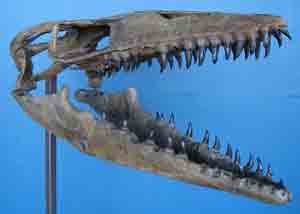Fossil Tooth Mosasaur Giant Sea Reptile cm 7.2 x 2.6 x 1.6 Mosasaurus beaugei Extinct Prehistoric Animals Mesozoic Cretaceous Collecting Paleontology Museum.
Remarkable collectible fossil find in good condition, conodont tooth, complete with root, with appreciable anterior and posterior details. Only a piece, as in photos.
 Mosasaurus (whose name means "Meuse river lizard") is an extinct genus of gigantic mosasaurid marine reptile that lived in the Upper Cretaceous, about 70-65 million years ago (Maastrichtian), in Western Europe, Morocco and North America.
Mosasaurus (whose name means "Meuse river lizard") is an extinct genus of gigantic mosasaurid marine reptile that lived in the Upper Cretaceous, about 70-65 million years ago (Maastrichtian), in Western Europe, Morocco and North America. The genus currently has five species: the type species
M. hoffmannii, M. missouriensis, M. conodon, M. lemonnieri and M. beaugei. Mosasaurus was one of the largest genera of its family to which it gives its name, as well as being one of the last mosasaurids to evolve before the great mass extinction of the Cretaceous-Paleocene. Contrary to what you might think, it is not a dinosaur.
Like most mosasaurids, the limbs had evolved into short but efficient flippers, and the front flippers were larger than the rear flippers. The largest known species, M. hoffmannii, could reach a length of 17-18 meters, slightly longer than its closest relatives Tylosaurus and Hainosaurus. Furthermore, Mosasaurus was also the most robust among the mosasaurids, reaching a considerable weight of 25-30 tons in the most developed specimens.
The skull was triangular, equipped with a jaw connected very closely to it, which was particularly robust and the bones that made it up were joined together more firmly than what happened in other mosasaurs, whose skulls were very mobile. The mosasaur's teeth were strong and curved backwards, capable of both cutting and breaking. The body was long, thick and barrel-shaped. The eyes were relatively large, but afforded poor binocular vision, and the olfactory bulbs were poorly developed, so experts believe that Mosasaurus lived near the surface of the ocean, where it preyed on fish, turtles, ammonites, plesiosaurs, and even smaller mosasaurs. Although they were capable of diving to great depths, it is more likely that they did not venture into too deep waters preferring to stay close to the surface, where it was easier to find food.
The skull of Mosasaurus gradually ended in a short conical point, and the jaws were armed with enormous conical teeth. The fins, like those of modern cetaceans, were supported by five fingers in the front flippers and four in the rear ones, joined together to form a single fin. The animal's tail, with 80 caudal vertebrae, was very strong and sinuous, and some mosasaurid fossils suggest the tip of the tail had a fork, like the tails of sharks and some ichthyosaurs (Lindgren et al., 2010). While swimming the body remained stationary to reduce drag through the water, while the tip of the tail provided powerful propulsion.
In 2009, several specimens of mosasaurid were described with well-preserved skin imprints composed of small diamond-shaped scales that overlapped each other: keeled scales, very similar to those of modern monitor lizards, which covered the upper part of the body and scales smooth on the belly. Since mosasaurs were probably ambush apex predators, it is assumed that these animals could have benefited greatly from the lack of reflexivity of keeled scales (Kaddumi, 2009).
Six mosasaur species are currently identified from marine deposits in Morocco. In
Mosasaurus beaugei (Arambourg 1952), the tooth crowns are described as robust with both keels (sharp edges) having fine serrations visible, the most noticeable feature being the very distinctive and pronounced prism-shaped longitudinal facets on the tooth crown. The teeth have an almost triangular cross section and the facets can also be even more pronounced. It was a giant that reached 12 meters in length and is one of the largest species identified in Morocco.



